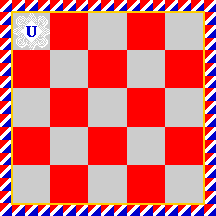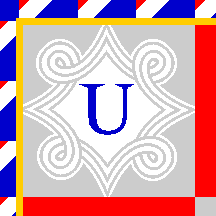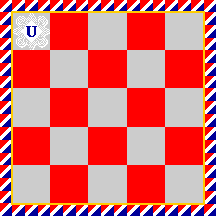
by Željko Heimer

Last modified: 2005-02-19 by dov gutterman
Keywords: croatia | hrvatska | poglavnik | vojskovodja |
Links: FOTW homepage |
search |
disclaimer and copyright |
write us |
mirrors
See also:

detail of hoist upper corner ("curl")
by Željko Heimer, 4 October 1999
I just received most kindly from Emil Dreier some
materials on the flags of WW II Croatia. Among other things there
is the copy from official gazette that can certainly remove all
questions regarding this flag. Both my image sent previously, and
the one sent by Mark, as well as some
other images shown in vex- publications, have some minor errors
according to the prescriptions in official gazette. Instead of
listing what is wrong and what is right, I better give the
definition as given there, and then if necesserily take a look at
certain elements remaining "unclear".
The source is "Zakonska odredba o drzavnom grbu, drzavnoj
zastavi, Poglavnikovoj zastavi, drzavnom pecatu, pecatima
drzavnih i samoupravnih ureda" (Legal regulations on the
state coat of arms, the state flag, the flag of Poglavnik, the
state seal and the seals of state and self-governing offices), 28
April 1941, issued in "Narodne novine" (Official
gazette) nr. 15/CV, 30 April 1941 and signed by Poglavnik Dr.
Ante Pavelic. The regulations became valid on the day of issue in
the official gazette.
The article 3 define the flag of Poglavnik ("leader").
My translation follows:
"The flag of Poglavnik, that is hoisted in his office, on
his quarters if he is present, and which is carried beside him in
all ceremonial occasions, is the flag of 25 square fields,
interchangeably white and red (blood colour), ordered in five
rows so that in upper first row the first field is white. In that
row, in the first white field near hoist is the curl ["curly
ornament"] described in article 1 made in silver on white
area, and in the middle of the curl is big [capital] dark blue
letter U. Around these 25 fields there is a thin golden border,
and around this outer border consisting of squares diagonally
divided by white stripe. The upper triangle gained by this is red
(blood colour), while lower is blue. Three of such squares come
to one square of the chequy filed of the flag."
For understanding this, we need part of article 1 describing the
"curl":
"... sign star-like in shape made of tripple-wattle curl of
the same red colour, in which there is big [capital] letter U of
dark blue."
The same red colour, is the colour of croatian flag defined as
blood red throughout the regulations in paranthesis. However, it
is clear from art. 3 that in the flag of Poglavnik this
"curl" is made of silver (probably it was really made
of real siver threads), and not red.
Article 5 of the same regulations define that the images
accomapnying it are intergal part of it. And indeed this issue of
the official gazette have the images. The questions not clear
from the regulations can be sorted out from the image. The width
of the golden border is not defined, but obviously it was not
intended to - it is "as thin as possible to be still
visible". I would guess it was made as thick as the thread
was. The size of "white bend sinistre" in the outer
border squares in hard to define. They seem not to be all the
same all around the border, which is, I believe, the effect of
unperfect printing technique of the time. There also seems that
here or there, there are white "fibrilations" between
touching red and blue triangles, which are not supposed to be
there in real flag (nor have I ever seen them in photographs of
the flag), and they must be another printing effect. What is most
misterious are the corner cheques, two of which seem bigger,
while other two do not. since the descriprion does not mention
any difference, I would guess that this is yet another effect,
and that they should all be of the same size. There might also be
that they seem bigger due to the effect produced by the golden
outline which do not "cover" them as it cover other
squares in the border. The size of white bend is hard to estimate
numerically, but it is apprximately as on my image (and
certainly, red and blue triangles have common edge, not only a
point).
From the b/w copy of the official gazzete it is possible to
speculate that the white chqeues on the image are actually
silver, though the text do not mention that and explicitly say
that they are white (on contrary mentioning that the
"curl" is silver on white "area"). The same
thing can be concluded from Neubecker (page 103a, of which I have
also b/w copy, but according to Ivan Sache's comments
accompaning it they cheques are there silver too). In fact, one
can clearly see difference of the first cheque field colour
(silver) and the white background of the "curl").
Željko Heimer, 4 October 1999
I stumbeled today on some photos of the car flags used in the
Independent State of Croatia in 1941. I scanned from daily
newspaper "Jutarnji list" (8 January 2005) reprinted
from a book in preparation by Slavko Goldstein "1941.".
Coloured photo showes the
reception of a foreign high delegation on Borongaj military
airfield in Zagreb, 1941. There is in the front Poglavnik's car
with his personal standard attached on the right fender.
The B/W photo showes the
ceremonial parade in Zagreb 1941 (probably on some other
occasions), with the same flag on the car.
Željko Heimer, 8 January 2005

by Mark Sensen , 30 September 1999
Today I received some flag books I ordered from an Internet
book shop. One I received was: N. Thomas & K. Mikulan,
"Axis Forces in Yugoslavia 1941-5" (Men-at-arms series,
no. 282), Osprey Publishing, 1995.
I browsed it, and on a colour plate (hand drawing) I discovered a
flag which I looked up on Željko's FAME
pages. It was the Poglavnik's personal standard. But the border
was a little different:
A: all squares are of equal size (on Željko's site the ones in
the corners are a little bit bigger)
B: all squares have the red at the top and the blue at the bottom
(on Zelkjo's site the squares at the fly and bottom are the other
way around)
C: the white stripe in the squares are wider, it looks as if the
border between red and white continues as the border between
white and blue in the neighbouring square.
I'm not claiming this is the right desgin (it wasn't a photo, but
a drawing by hand), but maybe it contains something usefull.
Mark Sensen, 30 September 1999
Neubecker has two different (mirorred) pattern of the curl for
the Poglavnik's standard and the national flag! What Željko
Heimer have giffed is what Neubecker uses for the national
flag. what Neubecker uses for the Poglavnik's standard is a
mirrored version of your curl. (here are a sketch of both
versions, fide Neubecker.)the difference is difficult to explain
and seems minor, but is evident when you look carefully at
Neubecker's plate - I assume there is a mistake in Neubecker, but
this does not tell you which curl is correct.
Ivan Sache, 5 October 1999
It is true what you say about Neubecker, and it is the same in
the images from the official gazette, though it seems that this
difference is nowhere prescribed (the text doesn not mention it -
it explicitly say that the curl should be the same apart from
colour!). Looking further into some other places where this
simbol apears that were at hand (stamps, money, box of matches
and some other places) it seems that the curl was made any way it
suited them - and made no difference.
In the photographs of the real
flag, it is hard to say what was "the way the curl
went", the details are usually so small.
In a meterial of unknown source (which include all of those many
1944 rank flags) that was among the papers of Neubecker for his
prepaired (and never issued) 1944 issue of the great flagbook,
that I was kindly given by Dr. Emil Dreyer, the curls
are all in the same direction, and that is exactly oposite of the
one I posted previously (and oposite of the national flag
according to official gazette).
However, as I said, I would guess that the diection of the curl
was ignored and of no significance. Though for the my images , we
may as well follow the pattern used in the official gazette, and
have the "proper" image
Željko Heimer, 17 October 1999
The flag (stieg - standard) of the Minister of Armed Forces is
white square with blue cross (width of the cross 1/8 of the flag
hoist), and over that is set the state coat of arms (height 6/11
hoist). The state coat of arms is composed of a white and red
chequy shield above which is set the Ustasha symbol - the letter
U in triple wattle.
Željko Heimer
The flag for other ministers members of the Government is
similar to the flag of the Minister of Armed Forces, but instead
of the cross, it is bordered with a blue border (width 1/10 of
hoist).
Željko Heimer
In my correspondence with Krunoslav Mikular, he sent
me info on a Croatian WWII flag I have not found mentioned in any
vex sources known to me - the flag of Vojskovodja.
Vojskovodja was the highest rank of the Independent State of
Croatia regular army (Domobrani = "home guard"),
equaled with the rank of Marshal. The only person that bore it
was Slavko Kvaternik, from April 1941 to January 1943, when he
was retired. Kvaternik was, in the same time the "Ministar
Hrvatskog Domobranstva" (comparable with defence ministry).
The Ministry was renamed in January 1943 to "Ministarstvo
Oruz<anih snaga", and took the command over the Ustasa
forces (Ustas<ka vojnica), as well, which was until then
separate body. since then the term "Domobranstvo"
designated only the Army ("land forces") and not the
entire armed forces. (information thanks to Krunoslav Mikulan).
The flag of Vojskovodja is shown in "Domobranski
priruc<nik" ("Military gudiebook") issued in
1942. The image is black and white, with stripes hatched with
heraldical lines for red and blue, while the elements encirceling
the coat of arms are not hatched. Comparing the practice used on
Poglavnik's flag as well as on the Air Force ensign, I have
assumed that these elements are embroideried in slik and outline
black, but that might be wrong.
The flag is square Croatian tricolour with the Croatian coat of
arms (chequy shield, "first-white" square), outlined
with border, off-set somewhat lower then the flag center, set
over two sword in saltire, topped with air forces badge (spread
eagle) wich in turn is topped with "U" wattle from the
state coat of arms, in which "U" is replaced with
initials "NDH" (for "Nezavisna Drz<ava
Hrvatska", official name of the state. This symbol (i.e. all
what was found on tricolour) was the badge of
"Domobranstvo".
Interesting, the eagle in the badge is slightly different from
the eagle set in the Air Force ensign. It is turned towards hoist
in this flag, and it have one more "feather" in the
lower parts of wings. Nevertheless, both images on which are
based my drawings are from the same source, which may be
indication that really two different bades were used. Though I am
not quite convinced, and would assume that the differences are
due to the "artistic freedom" of the illustrator of the
guidebook.
As I have said, the vexillologic sources are silent about this
flag, and that may be due to one particular fact - most of the
sources are derived from Neubecker collection, which have been
prepaired (for these flags) in 1941, when the flag might have not
yet been in use, and in 1944 (huge set of rank flags, never
confirmed by Croatian sources, AFAIK) when this flag would be
outdated. So, it may be that this flag was overlooked only due to
"misfortunate" use period.
Željko Heimer, 30 December 1999
The rank flag of the Vojskovodja (marchal) of Croatian
Domobranstvo (regular army) Slavko Kvaternik is square Croatian
tricolour, with a silver symbol of Domobranstvo in the
middle. The symbol is composed of the shield of Croatian coat of
arms in front of the two swords in saltire, topped by an eagle
and triple wattle with inscription NDH.
Željko Heimer
The flag of the Commander of Armed Forces is white square with
blue cross (width of the cross 1/8 of the width of the flag) with
the state coat of arms (height 4/11 of flag width) in the canton.
Željko Heimer
The flag of an admiral is white square with blue cross (width
1/8 of hoist).
Željko Heimer
The flag of a vice-admiral is equal to the admiral's flag,
defaced with a blue trefoil in the first quarter. The trefoil (trolist),
also called the cross of Zvonimir (Croatian king
Zvonimir-Demetrius, ruled 1075-1089) is a marking of the armed
forces of the Independent State of Croatia (also used during
Austria-Hungary in Domobranstvo). On admirals' and
generals' flags it is used to denote rank. The admirals' flags
follow the model (in use by most of navies at the time) where
more markings denote lesser rank. The flags of generals use
another model (used mostly by armies in Europe during World War
II, also) where more markings on the flag denote higher rank.
Željko Heimer
The flag of a rear admiral is equal to the admiral's flag,
defaced with a trefoil in first and third quarter each.
Željko Heimer